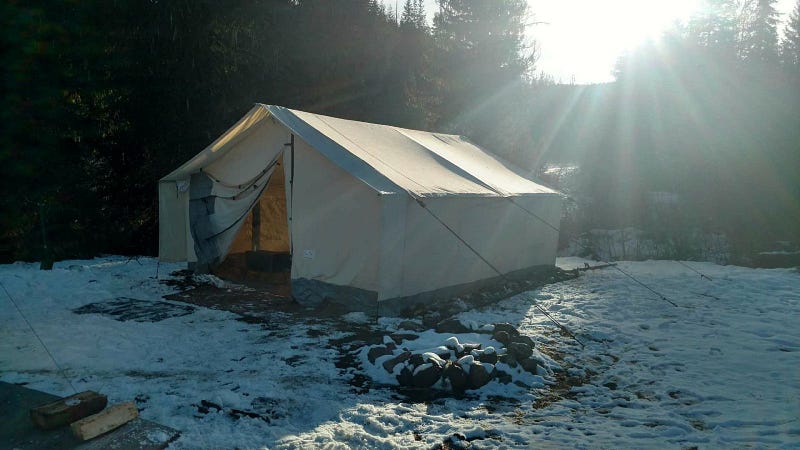We have combined our accumulated experience and believe in the philosophy “truth is in the details” with innovation today in textile manufacturing to produce tents that exceed our customer’s expectation.
We use an Army Duck Cotton Canvas 10.10 Oz, 100% Cotton with a high-density weave structure. Our Canvas Tent fabric has UV, Anti-Mildew & Waterproofing agent saturated throughout the canvas before manufacturing so even after wear and tear it will still provide a waterproof barrier.
We achieve a high value of hydro-static water head creating a waterproof canvas that minimizes condensation build up. The canvas tents’ structure of cotton allows moisture to pass through and at the same time provide a barrier to water droplets.
We also offer a range of Flame Retardant finish meeting CPAI 84 USA Outdoor Camping Standard.
Understanding the Water Proof
Our canvas tents are manufactured from waterproof and water repellent fabrics. However, with the addition of seams, zips and other desirable features for camping, hunting, recreation, glamping tent cannot be as waterproof as a car, house or other solid structures.
Our canvas tents are manufactured from waterproof and water repellent fabrics. However, with the addition of seams, zips and other desirable features for camping, hunting, recreation, glamping tent cannot be as waterproof as a car, house or other solid structures.
Following are the common examples of how water can enter a camping/glamping tent. Hence, corrective actions and notes to consider are:
Condensation
When warm moist air meets cooler air, condensation of water gas into water liquid occurs. The tent walls and roof form an impermeable layer between the inside and outside climatic conditions. The moisture inside the tent condenses on the canvas fabric and water droplets are formed. Sometimes these water droplets build up to appear that the fabric is leaking when in fact the cause is condensation. Condensation can be reduced if the tent is well ventilated to reduce the buildup of warm moist air on the ceiling.
When warm moist air meets cooler air, condensation of water gas into water liquid occurs. The tent walls and roof form an impermeable layer between the inside and outside climatic conditions. The moisture inside the tent condenses on the canvas fabric and water droplets are formed. Sometimes these water droplets build up to appear that the fabric is leaking when in fact the cause is condensation. Condensation can be reduced if the tent is well ventilated to reduce the buildup of warm moist air on the ceiling.
Zips
All care is taken in the canvas tents’ design to cover zips with storm flaps or position them where water will not flow. At times wind driven rain could force water under the flaps and through the zips. To minimize this, ensure all doors and windows are closed with flaps securely covering the zip wherever possible. If the ground is very wet or water pools under the floor, then the downward pressure of standing or kneeling on the floor can draw water through minute wear holes in the floor fabric or where there are joins in the floor fabric. To prevent this, do not set up the tent in hollows and make sure water drains away from the tent site.
All care is taken in the canvas tents’ design to cover zips with storm flaps or position them where water will not flow. At times wind driven rain could force water under the flaps and through the zips. To minimize this, ensure all doors and windows are closed with flaps securely covering the zip wherever possible. If the ground is very wet or water pools under the floor, then the downward pressure of standing or kneeling on the floor can draw water through minute wear holes in the floor fabric or where there are joins in the floor fabric. To prevent this, do not set up the tent in hollows and make sure water drains away from the tent site.
Structural Integrity
A well set-up cotton canvas tent on level ground is structurally strong and most waterproof. During periods of prolonged rain and wind it may be necessary to tighten and adjust the frame, pegs and guy ropes as well as making sure any groundwater is flowing away from the campsite. A sagging roof or awning weakens the tent structure and could allow water to collect on the roof causing leakage, structural damage, and fabric tears.
A well set-up cotton canvas tent on level ground is structurally strong and most waterproof. During periods of prolonged rain and wind it may be necessary to tighten and adjust the frame, pegs and guy ropes as well as making sure any groundwater is flowing away from the campsite. A sagging roof or awning weakens the tent structure and could allow water to collect on the roof causing leakage, structural damage, and fabric tears.
Wet Tents
A Water & Mildew Canvas Tent will definitely survive the test of nature in the great outdoors. However, there is a certain element of extra care a camper needs to undertake to ensure the tent performs over the years. Never pack a soiled or wet tent. Make sure the tent is dry and dusted prior to packing it back.
Cotton tents, if packed in airtight bags will cause the microorganism to grow on it.
A Water & Mildew Canvas Tent will definitely survive the test of nature in the great outdoors. However, there is a certain element of extra care a camper needs to undertake to ensure the tent performs over the years. Never pack a soiled or wet tent. Make sure the tent is dry and dusted prior to packing it back.
Cotton tents, if packed in airtight bags will cause the microorganism to grow on it.
Hence, the practice of ensuring the above mentioned key points is mandatory.

No comments:
Post a Comment